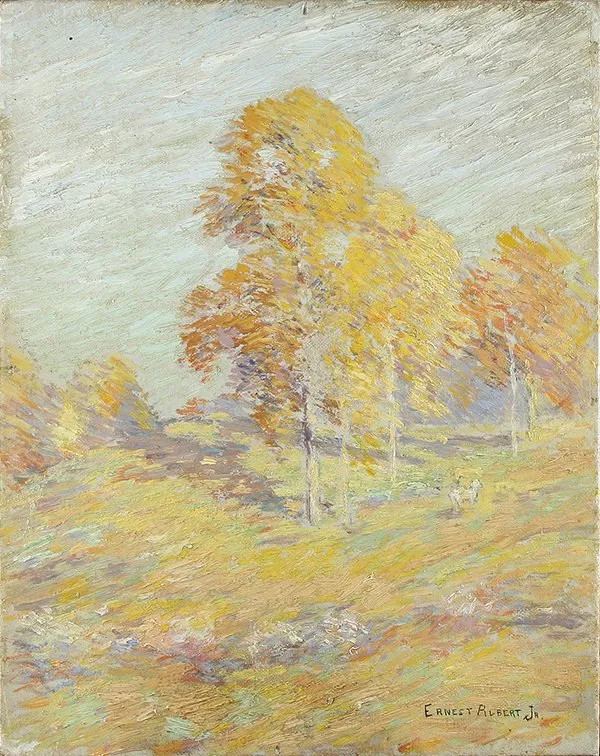-
Artist: Ernest Albert Jr. (American, 1890-1955)
Son of painter Ernest Albert Sr, Ernest Albert Jr was born on August 1, 1890 in Chicago, Illinois. The family moved to New Rochelle, New York (only 30 miles from Manhattan) where Ernest Jr attended public schools, and entered the Art Student League in 1905. Only 1 year later in 1906, Ernest Jr painted a watercolor of Grand Central Station that became part of the collection for the New York Historical Society. In 1908, both Ernest Jr and Ernest Sr went to Lyme, Connecticut where they not only sketched the countryside, but met Woodrow Wilson (then President of Princeton University). Ernest Jr studied under his father and other well-known artists of the time, including L. Lewis Moran, Frank Vincent Dumond and Edward Ruffer.
Beginning in 1916, Ernest Jr began exhibiting his work through the New Rochelle Library, the New Canaan Society of Artists and the Salmagundi Club, to which he was elected as a member in 1917. Ernest Jr was a contemporary of Norman Rockwell, and his first exhibition was a joint exhibit with that icon of American illustrative art.
In 1918, Ernest Jr was very briefly inducted into the army during World War I, but was honorably discharged several months later. That period also saw the passing of the 18th Amendment to the US Constitution and the famed “Prohibition” period of American history which did not end until 1933. Ernest Jr. continued his art career, and won several awards for his painting, including the Adolph Grant Prize in 1921 and E. Irving Prize from the Salmagundi Club in 1923. Ernest Jr completed much commercial art work for the Red Cross (as early as 1917), the Wing-Thayer Advertising Company, the Charles Daniel Frey Advertising Company, and Country Living (cover art in 1924) while also maintaining a landscape art studio and continuing to contribute works to galleries such as the Casson Galleries in Boston. It was around this time when Ernest Albert Jr also began to be known also as E. Maxwell Albert. By 1926, Ernest Jr was living in New Canaan and was a member of the Salmagundi Club, the Lyme Art Association, the Allied Artists of America, and the Silver Mine Guild.
Ernest Albert Jr never married, though he briefly considered marriage to Miss Stella Walters in 1926. Through the Great Depression and beyond, Ernest Jr continued his career as an artist, but also completed much restoration work, particularly for the governor’s Art Project in Connecticut. His association with that project, and his fame in New Canaan led to many of his works being displayed in public buildings in New Canaan and Hartford, Connecticut---the city where Mark Twain wrote some of his most enduring novels. Through the late 1930’s and into the 1950’s, Ernest Jr continued his career as an academic impressionist, eschewing the profound changes occurring in post-modernism and abstract expressionism. Ernest Albert Jr, also known as E. Maxwell Albert, died in 1955.
Sources:
AskART.com. Biography for E. “Bill” Maxwell Albert [Internet]. [cited 2013 July 16].
Available at: http://www.askart.com/askart/artist.aspx?artist=22225.
Wolf’s Fine Art. “Albert, E. Maxwell (Bill), AKA Ernest Albert, Jr. American, 1890-1955” [Online]. 2003[revised 2010 Sep 24; cited 2013 July 1].
Available at: http://www.wolfsfineart.com/biographies.htm#Albert.
